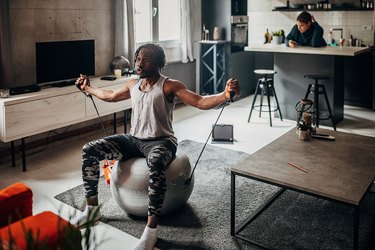

A major perk of seated workouts is that they allow you to focus on proper form and engaging the right muscles. And you don't need to have a mobility issue to do seated exercises; everyone can benefit from taking their lower body out of the mix to hone in on their shoulders.
"Although both seated and standing shoulder exercises train the same regions of your shoulders, the seated variation eliminates stress on your core, which can be beneficial for beginners or those who have lower-back injuries," says Ronny Garcia, CPT, a Long Island–based certified personal trainer at Blink Fitness.
Video of the Day
Strengthening your shoulder muscles is important for carrying out a variety of daily tasks, such as lifting and reaching for overhead objects. That's because your shoulder joint controls many arm functions, like adduction (moving your arm toward the center of your body), abduction (moving your arm away from the center of your body) and rotation, Garcia says.
"Your shoulders aid in posture by utilizing the scapula, and [they're the main muscle group] in many sports, such as baseball, tennis and swimming. Weakness or injury in these muscles and joints can make these sports and everyday tasks difficult," he explains.
Try this 20-minute seated resistance band workout to give your shoulder muscles some TLC. All you need is a light resistance band with handles. Garcia recommends beginners start with 2 sets of 10 to 12 reps per move. As you get stronger, you can increase to 3 sets of 15 reps and switch to a heavier band.
Check out more of our 20-minute workouts here — we’ve got something for everyone.
1. Seated Lateral Shoulder Raise
Lateral shoulder raises train the medial head of your shoulder, which is used to raise your arms to the sides, Garcia says.
- Sit down on a chair, exercise box or bench with your feet hip-width apart. Place your resistance bend under your feet, keeping your feet at the center of the resistance band. Hold one handle in each hand by your sides.
- Keeping your arms straight and your back upright, brace your core and lift your arms out to the sides until they reach shoulder height.
- Slowly lower your arms by your sides.
- Do 10 to 12 reps.
2. Seated Single-Arm Overhead Press
The shoulder press works all three heads of your shoulders, including your anterior (front), posterior (rear) and lateral (side) deltoids, Garcia says.
- Sit down on a chair, exercise box or bench with your feet over the left end of the resistance band on the ground. Hold the other handle with your right hand by your shoulder.
- Keeping your back upright and your core braced, press your right arm overhead, finishing with your biceps by your ears.
- Lower your arm back down to the starting position.
- Do 10 to 12 reps, then switch sides.
3. Seated Front Shoulder Raise
Front raises train the anterior (front) head of your shoulders. Together with the lateral raises, front raises aid in stabilizing your shoulders and preventing the dislocation of the head of the humerus under load, Garcia says.
- Sit down on a chair, exercise box or bench with your feet hip-width apart at the center of the resistance band, holding one handle in each hand by your sides.
- Keeping your arms straight and your back upright, brace your core and lift your arms in front of you until they reach shoulder height, palms facing down.
- Slowly lower your arms back down to the starting position.
- Do 10 to 12 reps.
4. Overhead Band Pull-Apart
Unlike the traditional band pull-apart, the overhead band pull-apart emphasizes using your teres major, the rectagular-shaped shoulder muscle, which is part of your latissimus dorsi (large back muscles), Garcia says. In fact, the teres major is known as the "little lat," according to the American Council on Exercise.
"I recommend training your shoulders in all their joint function to aid in mobility and strength," he says.
- Sit down on a chair, exercise box or bench with your feet hip-width apart. Hold one end of the resistance band in each hand overhead shoulder-width apart, palms facing forward.
- With your back upright, core braced and palms facing forward, pull the band apart to the sides of your body, lowering your arms to shoulder height.
- Bring your arms back overhead to the starting position.
- Do 10 to 12 reps.
5. Band Pull-Apart
The band pull-apart targets your upper-back and shoulder muscles, which are important for maintaining good posture.
- Sit down on a chair, exercise box or bench and hold one end of the resistance band in each hand shoulder-width apart. Lift your arms straight in front of you with your palms facing down and knuckles facing forward.
- Keeping your arms and wrists straight, pull the band apart wide across your chest, drawing your shoulder blades together. Pull as wide as you can while maintaining good posture.
- Slowly release the band to bring your arms back to the starting position.
- Do 10 to 12 reps.
Was this article helpful?
150 Characters Max
0/150
Thank you for sharing!
Thank you for your feedback!